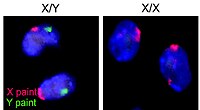| Part of a series on |
| Sex |
|---|
 |
| Biological terms |
| Sexual reproduction |
| Sexuality |
| Sexual system |
The mechanics of human sexuality or mechanics of sex, or more formally the biomechanics of human sexuality, is the study of the mechanics related to human sexual activity. Examples of topics include the biomechanical study of the strength of vaginal tissues[1] and the biomechanics of male erectile function.[2] The mechanics of sex under limit circumstances, such as sexual activity at zero-gravity in outer space, are also being studied.[3]
Pioneering researchers studied the male and female genitals during coitus (penile-vaginal penetration) with ultrasound technology in 1992[4] and magnetic resonance imaging (MRI) in 1999, mapping the anatomy of the activity and taking images illustrating the fit of male and female genitals.[5] In the research using MRI, researchers imaged couples performing coitus inside an MRI machine.[5] The magnetic resonance images also showed that the penis has the shape of a boomerang, that one third of its length consists of the root of the penis, and that the vaginal walls wrap snugly around it.[5][6] Moreover, MRI during coitus indicate that the internal part of the clitoris[7][8] is stimulated by penile-vaginal movements.[9][4] These studies highlight the role of the clitoris and indicate that what is termed the G-spot may only exist because the highly innervated clitoris is pulled closely to the anterior wall of the vagina when the woman is sexually aroused and during vaginal penetration.[10]
- ^ Cosson, Michel; Lambaudie, Eric; Boukerrou, Malik; Lobry, Pierre; Crépin, Gilles; Ego, Anne (2004). "A biomechanical study of the strength of vaginal tissues. Results on 16 post-menopausal patients presenting with genital prolapse". European Journal of Obstetrics, Gynecology, and Reproductive Biology. 112 (2): 201–5. doi:10.1016/S0301-2115(03)00333-6. PMID 14746960.
- ^ Udelson, Daniel (2007). "Biomechanics of male erectile function". Journal of the Royal Society Interface. 4 (17): 1031–48. doi:10.1098/rsif.2007.0221. PMC 2396202. PMID 17478408.
- ^ Boyle, Alan (July 24, 2006). "Outer-space sex carries complications". NBC News.
- ^ a b Buisson, O.; Foldes, P.; Jannini, E.; Mimoun, S. (2010). "Coitus as revealed by ultrasound in one volunteer couple". J. Sex. Med. 7 (8): 2750–2754. doi:10.1111/j.1743-6109.2010.01892.x. PMID 20626602.
- ^ a b c Schultz, Willibrord Weijmar; van Andel, Pek; Sabelis, Ida; Mooyaart, Eduard (1999). "Magnetic resonance imaging of male and female genitals during coitus and female sexual arousal". BMJ. 319 (7225): 1596–600. doi:10.1136/bmj.319.7225.1596. PMC 28302. PMID 10600954.
- ^ Stuttaford, Thomas; Godson, Suzi (October 6, 2007). "Taking the first steps". The Times.[dead link]
- ^ O'Connell, H.E.; Hutson, J.M.; Anderson, C.R.; Plenter, R.J. (1998). "Anatomical relationship between urethra and clitoris". The Journal of Urology. 159 (6): 1892–1897. doi:10.1016/s0022-5347(01)63188-4. PMID 9598482.
- ^ O'Connell, H.E.; DeLancey, J.O. (2005). "Clitoral anatomy in nulliparous, healthy, premenopausal volunteers using unenhanced magnetic resonance imaging". The Journal of Urology. 173 (6): 2060–2063. doi:10.1097/01.ju.0000158446.21396.c0. PMC 1283096. PMID 15879834.
- ^ Foldes, P.; Buisson, O. (2009). "The clitoral complex: a dynamic sonographic study". J. Sex. Med. 6 (5): 1223–1231. doi:10.1111/j.1743-6109.2009.01231.x. PMID 19453931. S2CID 5096396.
- ^ Buisson, O.; Jannini, E.A. (2013). "Pilot echographic study of the differences in clitoral involvement following clitoral or vaginal sexual stimulation". J. Sex. Med. 10 (11): 2734–2740. doi:10.1111/jsm.12279. PMID 23937167.
